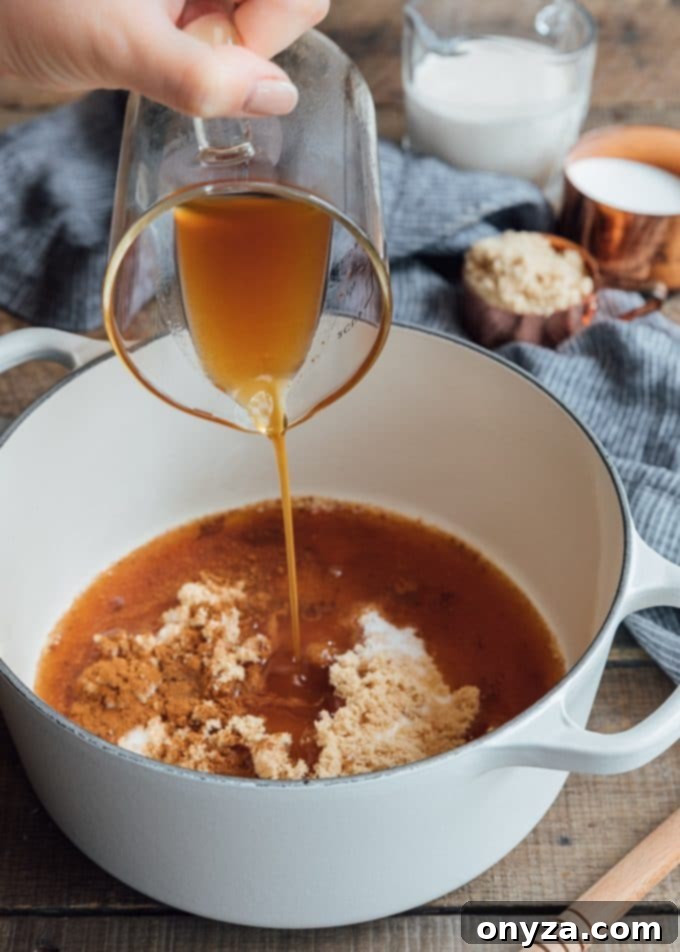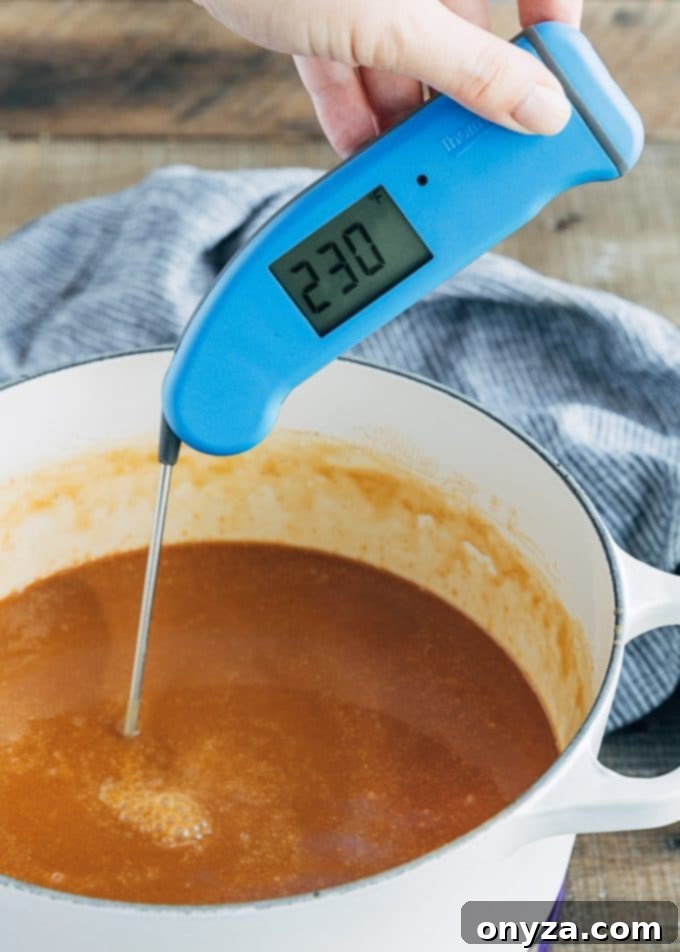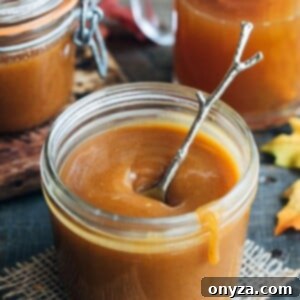Elevate your autumn desserts with our exquisite homemade Apple Cider Caramel! This simple-to-make caramel is perfect as a rich sauce or for dipping crisp fall apples.
Few things enhance a dessert or beverage quite like a generous drizzle of luscious caramel. While traditional caramel is always a delight, the changing seasons inspire a culinary journey to explore new, complementary flavors. Throughout the year, I find myself experimenting with various caramel infusions: a bright Lemon-Scented Caramel for sun-drenched summer days, a comforting Spiced Salted Caramel to warm the soul in winter, and of course, the star of autumn, Apple Cider Caramel.
Infused with the inviting aromas of cinnamon, the comforting sweetness of brown sugar, and the distinctive sweet-tangy essence of concentrated apple cider, this unique twist on a classic caramel truly captures the spirit of fall. Its rich, nuanced flavor profile makes it one of my absolute favorite seasonal indulgences, transforming ordinary treats into extraordinary autumnal experiences.
The Secret Ingredient: Homemade Boiled Cider for Unmatched Flavor
The foundation of our exceptional Apple Cider Caramel begins with a special component: boiled cider. This isn’t just a fancy step; it’s crucial for achieving the deep, intense apple flavor that distinguishes this caramel. Making boiled cider at home is surprisingly straightforward and requires minimal effort.

To prepare it, you’ll need a good quality, sweet apple cider and a sturdy pot. The process involves gently simmering 4 cups of cider until it reduces significantly, typically to about 1/2 cup. This reduction process concentrates the natural sugars and tangy notes of the apple, transforming it into a thick, syrupy concentrate. Imagine the vibrant flavor of four cups of cider packed into half a cup – that’s the power of boiled cider! This intensified apple essence brings a delightful dimension of tartness and profound apple character to the finished caramel, elevating it far beyond what mere apple juice could achieve.
While the reduction is largely hands-off, it does require some attention, especially as the volume diminishes. You’ll want to keep a close eye on the pot during the final stages of cooking to prevent the cider from scorching. As the mixture approaches its target consistency, it will become quite bubbly and almost foamy when stirred. This visual cue indicates you’re nearing the perfect point, ensuring a deeply flavored and perfectly reduced cider base for your caramel.
Crafting the Perfect Apple Cider Caramel: A Detailed Guide
Making caramel can sometimes feel like a delicate dance, often relying on visual cues like color. However, when it comes to Apple Cider Caramel, the presence of boiled cider and light brown sugar from the outset imparts a caramelized tone that makes traditional color-based judgment nearly impossible. This means a different approach is necessary, one that prioritizes precision and technique.

Unlike many classic caramel recipes where cold heavy cream is stirred in at the very end, causing a dramatic bubble-up, this Apple Cider Caramel recipe incorporates the cream from the beginning of the simmering process. This method helps prevent crystallization and allows the flavors to meld beautifully from the start. While you won’t experience the vigorous bubbling associated with adding cold cream to hot sugar, the mixture will still bubble as it cooks. Therefore, it’s crucial to use a heavy-bottomed pot with high sides to accommodate the caramel as it simmers and expands safely.
Given the challenge of judging doneness by color, an accurate candy thermometer or instant-read thermometer is an indispensable tool for this recipe. Precise temperature control is the key to achieving the perfect texture for your desired application. The final temperature will dictate whether your caramel is a silky, pourable sauce or a firm, dippable coating.
Understanding Caramel Cooking Temperatures for Optimal Texture
The versatility of this Apple Cider Caramel lies in its customizable texture, which is directly controlled by the final cooking temperature:
- If your goal is a delightful caramel sauce, ideal for drizzling over desserts, pancakes, or incorporating into beverages, cook the apple cider caramel to the “Thread Stage,” approximately 230 degrees F (110 degrees C). At this temperature, the caramel will be thick but still pourable when warm, and pliable when cooled in the refrigerator.
- For those craving classic, gourmet caramel-dipped apples or aiming to create standalone caramel candies, you’ll need a firmer consistency. Cook the caramel to the “Firm Ball Stage,” reaching temperatures between 245-250 degrees F (118-121 degrees C). The higher temperature results in a caramel that will solidify into a chewy, firm coating as it cools, perfect for holding its shape around an apple or as a standalone treat.
The hotter you cook the caramel, the harder and more solid it will become upon cooling. Investing in a reliable thermometer is highly recommended for consistent results. I personally rely on Thermoworks’ Thermapen ONE {affiliate link} for its incredible speed and accuracy, using it for everything from candy-making to roasting and grilling. It truly makes a difference in achieving professional-level precision in the kitchen.
Creative Ways to Enjoy Your Homemade Apple Cider Caramel
Once you’ve crafted a batch of this irresistible Apple Cider Caramel, the biggest challenge might just be resisting the temptation to enjoy it straight from the jar with a spoon (a purely hypothetical scenario, of course!). But beyond that immediate gratification, there’s a world of delicious possibilities waiting to be explored with this autumnal treat.

As previously mentioned, one of its most popular applications is creating show-stopping gourmet Caramel Dipped Apples. Imagine crisp, juicy apples coated in this rich, tangy caramel – a fall festival favorite brought right into your home, sure to impress family and friends alike. For an extra touch of decadence, try rolling them in chopped nuts or sprinkles.
When used as a luscious sauce, Apple Cider Caramel truly shines. Drizzle it generously over a warm slice of homemade apple pie à la mode, allowing it to melt into the vanilla ice cream and apple filling. It’s equally divine over brownies, cheesecake, or a simple bowl of vanilla bean ice cream. For bakers, this caramel makes an exquisite filling for delicate macarons, adding a sophisticated autumnal flavor to the classic French pastry. Consider incorporating it into other baked goods like tarts, cupcakes, or even as a swirl in a fall-themed bundt cake.
Beyond desserts, let your imagination run wild! Stir a spoonful into your morning coffee or latte for an instant seasonal upgrade. Use it as a topping for pancakes, waffles, or French toast for a truly indulgent breakfast. The possibilities are truly as vast as your caramel-loving heart can envision. This versatile caramel sauce or dip can be substituted anywhere you would typically use a traditional caramel, instantly infusing your creations with a distinct and delightful apple cider twist.

Print Recipe
Apple Cider Caramel
by Amanda Biddle
Rich, sweet, and slightly tangy apple cider caramel, made with reduced fresh apple cider and a hint of cinnamon. This is the perfect caramel for fall!
Ingredients
- 4 cups sweet apple cider
- ⅓ cup light brown sugar
- ½ cup granulated sugar
- ½ teaspoon kosher salt
- ¼ teaspoon ground cinnamon
- 1 cup heavy cream
Instructions
- Bring apple cider to a boil in a heavy-bottomed pot. Reduce heat to medium/medium-low to maintain a steady bubble, and cook until cider is reduced to 1/2 cup, about 30-60 minutes. Stir occasionally and watch it closely toward the end so it doesn’t burn.
- Strain reduced cider and return to a clean pot. Stir in light brown and granulated sugar, salt, cinnamon, and heavy cream.
- Bring to a boil and cook over medium-low heat, stirring occasionally, until the caramel reaches 230 degrees F (110°C) on a candy thermometer for caramel sauce, or 245-250 degrees F (118-121°C) for dipping apples.
- Caramel will thicken as it cools. Store, covered, in the refrigerator for up to one week. For easy reheating, store caramel in a microwave-safe container and warm in 10 to 15-second intervals until pourable.
Notes
- Caramel cooked to the temperature for sauce (230°F) will thicken in the refrigerator but will remain pliable and easily spoonable.
- Caramel cooked to the temperature for apple dipping (245-250°F) will solidify to a firm consistency. If preparing ahead for apples, store the caramel in a microwave-safe container. To re-soften, warm in 15-second intervals at half power until the caramel becomes fluid again.
Nutrition Estimate
Nutrition information is automatically calculated, so should only be used as an approximation.
Please note that our recipes have been developed using the US Customary measurement system and have not been tested for high altitude/elevation cooking and baking.
We hope this detailed guide inspires you to create your own batch of homemade Apple Cider Caramel. Whether you’re making festive dipped apples, enhancing your favorite desserts, or simply enjoying a spoonful as a seasonal treat, this caramel is sure to become a beloved part of your autumn traditions. Happy cooking!
